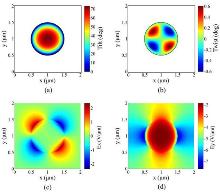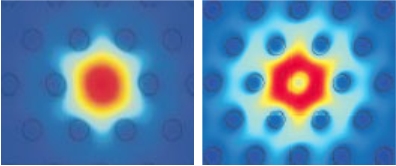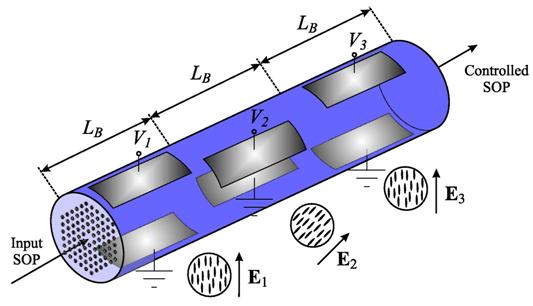
Photonic crystal fibers (PCFs) are a special class of optical fibers capable of guiding light via two distinct mechanisms: (a) index-guiding by a modified form of total internal reflection, and (b) bandgap-guiding due to the bandgap effect originating from a periodic cladding structure.
Nematic liquid crystalline (LC) materials consist of rod-like molecules which exhibit macroscopically orientation order along the “director”. The director’s pattern in confined cylindrical cavities is determined by the physics of elastic theory, the anchoring conditions at the cavity’s walls and the presence of external stimuli.
The infiltration of PCFs with LCs boosts them with special polarization properties, which can be tuned by controlling the orientation of the LC molecules via the application of an external voltage. The analysis of the switching mechanism of nematic materials infiltrated in the microcapillaries of a PCF requires the resolution of the coupled elastic/electrostatic problem, which yields the LC molecule local orientation and the distribution of the electric field (Fig. 1).
Our research focuses on the analysis of photonic crystal fibers infiltrated with nematic materials, aiming at the design of fibers which exhibit tunable properties, such as tunable modal birefringence (Fig. 2) or switchable operation. Various designs, based on different light guiding mechanisms are considered, including index-, bandgap- and hybrid-guiding PCFs. Furthermore, more complex components, such as polarization rotators and controllers (Fig. 3) are designed and theoretically analyzed, by simulation of light beam propagation through consequent sections of LC-infiltrated PCFs.
References
- D. C. Zografopoulos, A. Pitilakis, and Em. E. Kriezis, "Liquid crystal-infiltrated photonic crystal fibres for switching applications," Optofluidics, Sensors and Actuators in Microstructured Optical Fibers, Woodhead Publishing, ISBN 9781782423294, 55-83, (2015).
- A. Pitilakis, D. C. Zografopoulos, and Em. E. Kriezis, "In-line polarization controller based on liquid-crystal photonic crystal fibers," IEEE/OSA Journal of Lightwave Technology, 29 (17), pp. 2560-2569, (2011).
- D.C. Zografopoulos and E.E. Kriezis, "Tunable polarization properties of hybrid-guiding liquid-crystal photonic crystal fibers," IEEE/OSA Journal of Lightwave Technology, Vol. 27, pp. 773-779, (2009).
- D.C. Zografopoulos and E.E. Kriezis, "Tunable optical fiber polarization elements based on long-period gratings inscribed in birefringent microstructured fibers,"Journal of the Optical Society of America B, 25, pp. 111-118, (2008).
Fig. 1: LC switching in a cylindrical microcapillary. Tilt and twist angles, as well as the electric field distribution are rigorously modelled by solving the coupled electrostatic/elastic problem.
Fig. 2: Modal intensity profiles of the x- and y-polarized fundamental modes of a highly birefringent index-guiding PCF infiltrated with a nematic LC material.
Fig. 3: A voltage-driven polarization controller based on LC-infiltrated index-guiding PCF.




